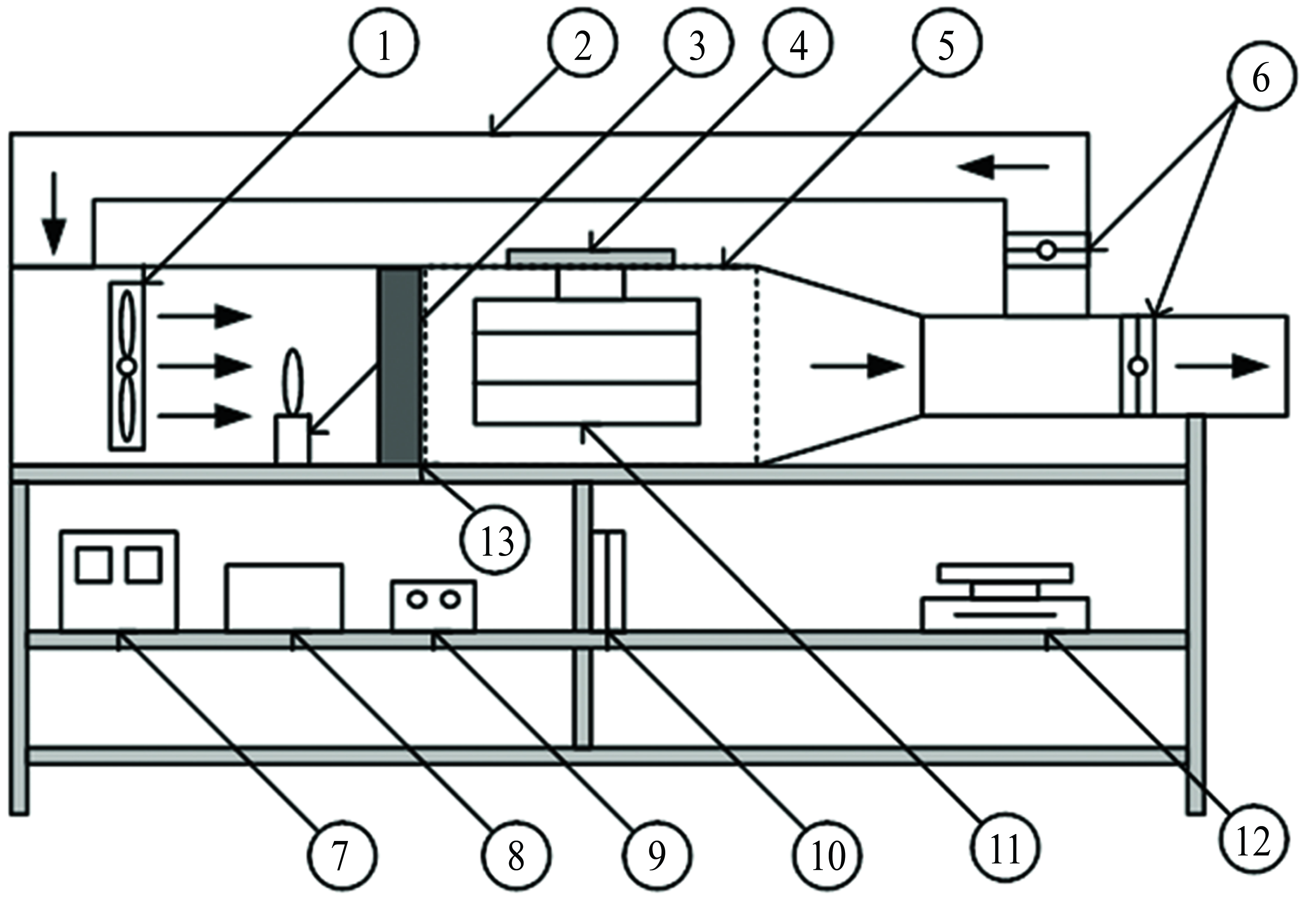การศึกษาอิทธิพลของสัดส่วนอากาศร้อนไหลเวียนกลับที่ส่งผลต่อพฤติกรรมการอบแห้งเนื้อปลานิลด้วยเครื่องอบแห้งลมร้อนที่ติดตั้งวัสดุพรุนชนิดตาข่ายสเตนเลส
Main Article Content
บทคัดย่อ
งานวิจัยนี้มีวัตถุประสงค์เพื่อศึกษาอิทธิพลของสัดส่วนอากาศร้อนไหลเวียนกลับที่ส่งผลต่อพฤติกรรม การอบแห้งเนื้อปลานิลด้วยเครื่องอบแห้งลมร้อนที่ติดตั้งวัสดุพรุนชนิดตาข่ายสเตนเลส เครื่องอบแห้งนี้ จะเป็นการพัฒนาการอบแห้งโดยการทำงานร่วมกันระหว่างลมร้อนไหลเวียนกลับและวัสดุพรุนก่อนเข้าห้องอบแห้ง เงื่อนไขในการอบแห้ง คือ อุณหภูมิ และความเร็วลมร้อนคงที่ 70 oC และ 2 m/s ตามลำดับ สัดส่วนของอากาศที่ไหลเวียนกลับ (Cair) เข้ามายังห้องอบแห้งเท่ากับ 0 40 60 และ 80 % ใช้เนื้อปลานิล เป็นวัสดุอบแห้ง และทำการเก็บข้อมูลระหว่างการทดลองทุก ๆ 20 นาที จนกว่ามวลของเนื้อปลานิลคงที่ ในการศึกษาพฤติกรรมการอบแห้งจะพิจารณาตัวแปรดังนี้ คือ ปริมาณความชื้นมาตรฐานแห้ง (Md) อัตราส่วนความชื้น (MR) อัตราการอบแห้ง (DR) และความสิ้นเปลืองพลังงานจำเพาะ (SEC) และสมการอบแห้งแบบชั้นบางได้ถูกนำเสนอเพื่อทำนายพฤติกรรมการอบแห้ง จากการทดลองพบว่า DR และ Md จะลดลงเมื่อระยะเวลาการอบแห้งเพิ่มขึ้น และ DR จะมีค่าสูงขึ้นเมื่อค่า Cair เพิ่มขึ้นและค่า Md สูง โดยเวลาที่ใช้ในการอบแห้งจะอยู่ระหว่าง 420 - 440 นาที และมีค่า DR สูงที่สุดเท่ากับ 0.22 kgwater/min ค่า SEC จะลดลงเมื่อ Cair เพิ่มขึ้น ซึ่งค่า Cair เท่ากับ 80 % จะสามารถลดค่า SEC ได้มากที่สุดถึง 49.60 % โดยมีค่า SEC ตํ่าที่สุดคือ 3.14 MJ/kgwater evaporated ที่ Cair = 80 % สำหรับการศึกษาสมการอบแห้ง แบบชั้นบางที่สามารถอธิบายพฤติกรรมการอบแห้งได้สอดคล้องกับผลการทดลองมากที่สุดคือ สมการ Modified Midilli ซึ่งมีคา่ R2 มากกวา่ 0.9964
Article Details
เอกสารอ้างอิง
[2] Toomthong, P., Teeboonma, U., Somsila, P., and Homchampa, T. (2012). Study on Drying Behavior of Tilapia nilotica Using Hot Air. Agricultural Science Journal. Vol. 43, 3 (Suppl.) pp. 115-118 (in Thai)
[3] Kesai, S., Kumwan, R., and Chotivisarut, N. (2012). A Potato Chips Dryer Using Infrared Gas Stove. A Thesis for The Degree of Master. Mechanical Engineering. Rajamangala University of Technology Lanna (in Thai)
[4] Duangjun, W., Tunme, S., Cheangsanoi, J., Krittacom, B., and Pongkun, J. (2012). A Study on Tilapia Drying with Hot Air Combine Porous Media. In 7th Engineering Science Technology and Architecture Conference 2012. Dusit Princess Korat, Nakhon Ratchasima, Thailand. pp. 475-479 (in Thai)
[5] Luampon, R. and Krittacom, B. (2016). Study Drying Kinetic of Tilapia using Hot Air Flowing through the Porous Media. In 13th Eco-Energy and Materials Science and Engineering Symposium. Udonthani, Thailand. pp. 325-327.
[6] Jugjai, S. and Polmart, N. (2003). Enhancement of Evaporation and Combustion of Liquid Fuels Through Porous Media. Experimental Thermal and Fluid Science. Vol. 27, pp. 901-909. DOI: 10.1016/S0894-1777(03)00062-1
[7] Luampon, R. (2018). Thin Layer Drying Model of Carrot Using a Heat Pump Vacuum Dryer. The Journal of King Mongkut’s University of Technology North Bangkok. Vol. 28, No. 1, pp. 147-155 (in Thai)
[8] Tippayawong, N., Tantakitti, C., Thavornun, S., and Peerawanitkul, V. (2009). Energy Conservation in Drying of Peeled Longan by Forced Convection and Hot Air Recirculation. Biosystems Engineering. Vol. 104, Issue 2, pp. 199-204. DOI: DOI: 10.1016/j.biosystemseng.2009.06.018
[9] Paengkanya, S., Soponronnarit, S. and Nathakaranakule, A. (2015). Application of Microwaves for Drying of Durian Chips. Food and Bioproducts Processing. Vol. 96, pp. 1-11. DOI: 10.1016/j.fbp.2015.06.001
[10] Baker, C. G. J. (2005). Energy Efficient Dryer Operation-an Update on Developments. Drying Technology. Vol. 23, Issue 9-11, pp. 2071-2087. DOI: 10.1080/07373930500210556
[11] Bruce, D. M. (1985). Exposed-Layer Barley Drying, Three Models Fitted to New Data Up to 150 C. Journal of Agricultural Engineering Research. Vol. 32, pp. 337-347
[12] Page, G. E. (1949). Factors Influencing the Maximum Rate of Air Drying Shelled Corn in Thin Layers. M.S. thesis. Department of Mechanical Engineering. Purdue University, Purdue, USA
[13] White, G. M., Ross, I. J., and Ponelert, R. (1981). Fully Exposed Drying of Popcorn. Transactions of the ASAE. Vol. 24, pp. 466-468
[14] Henderson, S. M. and Pabis, S. (1961). Grain Drying Theory II Temperature Effects on Drying Coefficients. Journal of Agricultural Engineering Research. Vol. 6, pp. 169-174
[15] Togrul, I. T. and Pehlivan, D. (2002). Mathematical Modeling of Solar Drying of Apricots in thin Layers. Journal of Food Engineering. Vol. 55, pp. 209-216. DOI: 10.1016/S0260-8774(02)00065-1
[16] Henderson, S. M. (1974). Progress in Developing the Thin Layer Drying Equation. Transactions of ASAC. Vol. 17, pp. 1167-1172
[17] Yaldiz, O., Ertekin, C., and Uzun, H. I. (2001). Mathematical Modeling of Thin Layer Solar Drying of Sultana Grapes. Energy. Vol. 26, Issue 5, pp. 457-465. DOI: 10.1016/S0360-5442(01)00018-4
[18] Wang, C. Y. and Singh, R. P. (1978). Use of Variable Equilibrium Moisture Content in Modeling Rice Drying. Transactions of American Society of Agricultural Engineers. Vol. 11, pp. 668-672
[19] Diamante, L. M. and Munro, P. A. (1991). Mathematical Modeling of Hot Air Drying of Sweet Potato Slices. International Journal of Food Science and Technology. Vol. 26, Issue 1, pp. 99-108. DOI: 10.1111/j.1365-2621.1991.tb01145.x
[20] Midilli, A., Kucuk, H., and Yapar, Z. (2002). A New Model for Single Layer Drying. Drying Technology. Vol. 20, Issue 7, pp. 1503-1513. DOI: 10.1081/DRT-120005864
[21] Charmongkolpradit, S. and Luampon, R. (2017). Study of Thin Layer Drying Model for Cassava Pulp. Energy Procedia. Vol. 138, pp. 354-359. DOI: 10.1016/j.egypro.2017.10.138
[22] Akgun, N. A. and Doymaz, I. (2005). Modeling of Olive Cake Thin-Layer Drying Process. Journal of Food Engineering. Vol. 68, Issue 4, pp. 455-461. DOI: 10.1016/j.jfoodeng.2004.06.023


